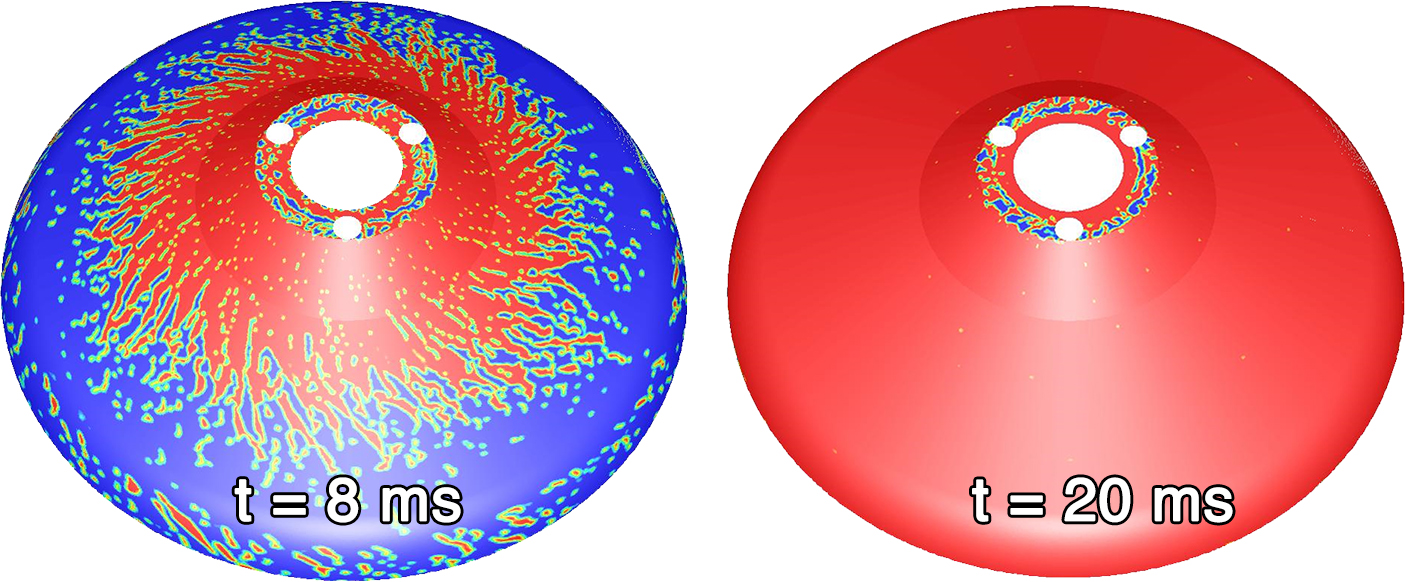ENGINEERING AND CFD
Liquid Break-up and Droplet Impact Simulation to Spread High Efficient Rotary Bells in SME Dominated General Industries
Principal Investigator:
Qiaoyan Ye and Oliver Tiedje
Affiliation:
Fraunhofer Institute for Manufacturing Engineering and Automation, Stuttgart, (Germany)
Local Project ID:
droplMP
HPC Platform used:
Hazel Hen of HLRS
Date published:
Project Description:
Spray painting is the most common application technique in coating technology. Small and medium-sized enterprises (SME) continue to use compressed air atomizers, although they no longer meet today's requirements from an economic and environmental point of view. The transfer efficiency (efficiency of the use of lacquer material) of a compressed air atomizer is only about 50%. Half of the lacquer material is lost as a so-called overspray that has to be disposed of in an elaborate way, such as the expensive spray booth technology because of the huge inlet and exhaust air for removing the paint overspray.
High-speed rotary bell atomizers provide an excellent paint film quality as well as high transfer efficiencies (approx. 90%) due to electrostatic support. In the automobile industry, almost all of compressed air atomizing processes have recently been replaced by the high-speed rotation atomization. However, for general industries or SME automotive suppliers high-speed rotary bell have not yet been widespread. Apart from the investment costs, there are still some practical problems, such as difficult adaption of atomizer parameters for geometrically complex workpieces, risk of atomizer contamination or occurrence of defects (e.g. pinholes) in the applied lacquer layer. It is therefore necessary to develop high-speed rotary bells that are suitable for easy to handle applications with wide ranges.
Atomizer development is usually being carried out mainly empirical with experimental methods. Although the liquid break-up process can be observed by using high-speed cameras (Fig. 2), it is difficult to investigate disintegration process quantitatively, e.g. drop sizes and velocities directly at the bell edge. An ongoing research project, Smart Spray Painting Process Using High-speed Rotary Bell, has been launched coordinated by the University of Stuttgart (IFF) and the Fraunhofer institute IPA. The project mainly focuses in detail on liquid atomization, droplet trajectory and impact processes by means of numerical simulation and experiments.
Thanks to high-performance computing (HPC) technologies such as provided by the High Performance Computing Center Stuttgart (HLRS), such investigation is made possible, namely the simulation of liquid break-up near the bell and micro droplets impingement. Figure 1 shows the wetting process on the bell cup, the time of 20 ms for the complete wetting is identical to the experimental observation. The calculation liquid disintegration process (Fig. 3) delivers detailed information on the primary breakup with droplet size, velocity and position, which provides accurate initial conditions for droplet trajectory calculations (Fig. 4). The droplet impact simulations (Fig.5) highlight the air entrapment mechanisms, from which bubble free conditions (decreasing defects of pinholes) in the liquid film can be obtained.
Complicated spray painting processes, such as atomization and droplet impact using high-speed rotary bell, can nowadays be described by means of numerical simulation using high performance computing. This allows for a huge step to minimize the ecological impact of coating processes by a systematic optimization of the equipment and the process. On the other hand digitalization will become more and more important for painting processes to handle to increasing complexity of small lot sizes and personalization. The numerical model of the complete spray coating process set the foundation of the digital intelligence of a machine or a work piece transforming it to a cyber-physical system.
Publications:
1. Qiaoyan Ye und Oliver Tiedje, Air entrapment in droplets impacting the surface, 2nd European technical coating congress 2014 3-5 Sep.2014, Gürzenich Cologne Germany
2. Qiaoyan Ye and Oliver Tiedje, Numerical study on air entrapment in droplets under impact onto a solid surface, ILASS – Europe 2013, 25th European Conference on Liquid Atomization and Spray Systems, Chania, Greece, 1-4 September 2013.
3. B. Shen, Q. Ye, O. Tiedje, W. Westkämper, Primary breakup of a paint liquid by a coaxial high-speed gas jet used in spray painting processes, 13th Triennial International Conference on Liquid Atomization and Spray Systems, Tainan, Taiwan, August 23-27, 2015.
4. Q. Ye and O. Tiedje, Numerical Study of Air Entrapment in Yield-stress Viscous Droplets under Impact onto a Solid Surface, ILASS – Europe 2016, 27th Annual Conference on Liquid Atomization and Spray Systems, 4-7 September 2016, Brighton, UK..
5. Ye, Q. and Domnick,J., Analysis of droplet impingement of different atomizers used in spray coating processes, J. Coat. Technol. Res. 14(2) 2017,467-476.
6. Qiaoyan Ye and Oliver Tiedje, Investigation on Air Entrapment in Paint Drops under Impact onto Dry Solid Surfaces, High Performance computing in Science and Enginering'16, 2016, 355-373
7. B. Shen, Q. Ye, O. Tiedje, J. Domnick, Primary breakup of liquids using a high-speed rotary bell atomizer for spray painting processes, ILASS–Europe 2017, 28th Conference on Liquid Atomization and Spray Systems, 6-8 September 2017, Valencia, Spain (http://dx.doi.org/10.4995/ILASS2017.2017)
Scientific Contact:
Dr.-Ing. Qiaoyan Ye
Fraunhofer-Institut für Produktionstechnik und Automatisierung IPA
Abteilung Beschichtungssystem- und Lackiertechnik
Nobelstraße 12, D-70569 Stuttgart (Germany)
e-mail: qiaoyan.ye[at]ipa.fraunhofer.de
http://www.ipa.fraunhofer.de/beschichtung




